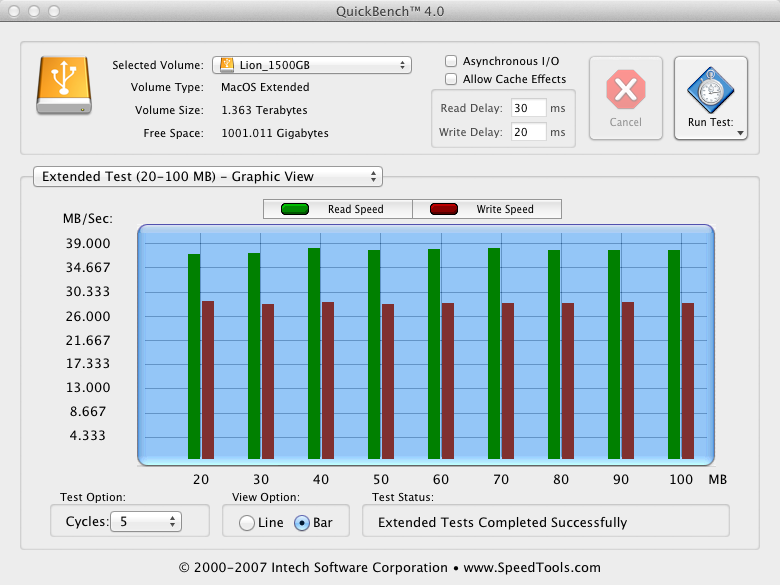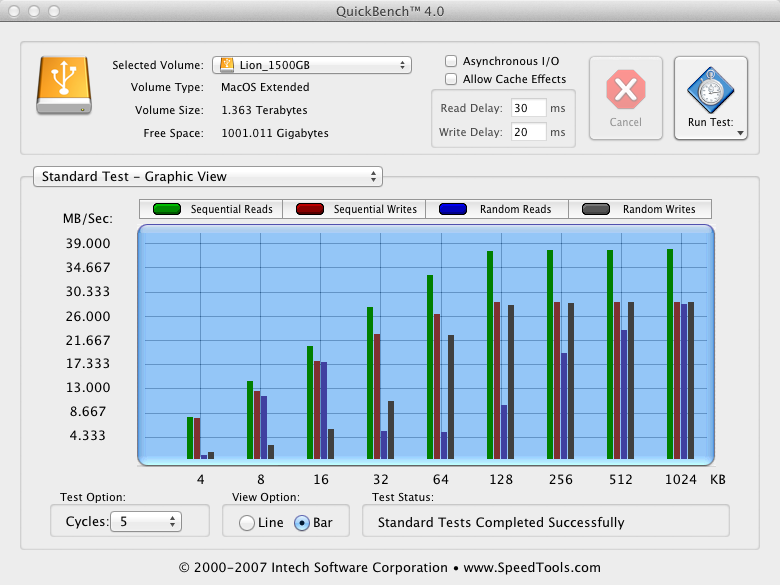Prefaced to say that b=bits and B=bytes - (as always).
--
Part of what the CalDit guy said is true but some of it is BS too. He's just not up on the current state of things is all. Remember the internal SATAII ports offer 300MB/s
each.
SATAI ~ SATAIII
- SATA revision 1.0 - 1.5 Gbit/s - 150 MB/s
- SATA revision 2.0 - 3 Gbit/s - 300 MB/s
- SATA revision 3.0 - 6 Gbit/s - 600 MB/s
But we should really be using GT/s because of the same 8/10 encoding that PCIe uses is present here as well. Thus for every 10 bits of data sent only 8 of them are data we care about as users. Multiplying the above numbers with 0.8 is not as much fun as just dividing by 10. So for actual throughput the list looks like this:
SATAI ~ SATAIII Speeds (each direction)
- SATA revision 1.0 - 1.5 Gbit/s - 120 MB/s
- SATA revision 2.0 - 3 Gbit/s - 240 MB/s
- SATA revision 3.0 - 6 Gbit/s - 480 MB/s
And it's a complete misnomer to think that "Real World" performance is any different at all. There are factors downstream and data treatments both upstream and downstream that can affect these speeds both positively and negatively. And of course there are also some natural physics that come into play - like rotational media seek speeds being affected by the weight of the drive heads, signal lag, and EM energy transference rates, etc. However for transfer sizes between ~300KB and 64MB (which describe 98% or our files these days) various protocols such as PTP/STP, NCQ etc., and inline subsystem components such as cache memory, overcome most of these impositions and can even lend in surpassing the manufacturer specified maximum rates by as much as 5% to 8% (typically!) and 10% to 15% in some cases. In a similar way the actual buss specifications can be exceeded by similar amounts as well. So this is to say that the common presumptions of thinking we will always get less than spec due to something no one can define, which we all call "Real World", is just wrong! If you're getting less than spec. for typical file sizes (mentioned above) there is likely one or more addressable bottlenecks causing it.
USB 2.0 - single connection, single rotational drive.
USB 2.0 - single connection, single rotational drive.
2-Drive RAID0 Internal
3TB Segate Barracuda, System caches disabled.
The situation is also similar when we begin discussing PCIe specifications and speeds. We need to match device specs across the board in order to maximize performance tho. Let not any user selectable component be a bottleneck.
Capacity Per Lane (each direction):
- v1.x: 250 MB/s (2.5 GT/s)
- v2.x: 500 MB/s (5 GT/s)
- v3.0: 985 MB/s (8 GT/s)
- v4.0: 1969 MB/s (16 GT/s)
For other lane multiples just use multiplication to determine throughput.
 16 Lane Slot (each direction):
16 Lane Slot (each direction):
- v1.x: 4 GB/s (40 GT/s)
- v2.x: 8 GB/s (80 GT/s)
- v3.0: 15.75 GB/s (128 GT/s)
- v4.0: 31.51 GB/s (256 GT/s)
GigaTransfers are kinda nice because you can just divide by 10 for the rate in Megabytes per second.

Like so:
- 100 GT/s = 80 Gb/s = 10 GB/s
- 200 GT/s = 160 Gb/s = 20 GB/s
And I'm old so I'm not sure what's happening with the v3 and v4 spec that it's not actually 8/10 as v1 ~ v2.x is. Perhaps someone with more current knowledge can clue us in.

I got the rates for those off of Wiki.
The Caldigit multi-port cards are just that too - crippling bottlenecks! Just by looking at the card I can tell they’re using a port-multiplication scheme (or VERY strange VLSI packaging) and I would be willing to bet they only call for a x1 buss. Port-multiplexing is bad. Bad bad PM! PM is basically how your USB hubs work. One connection, one line speed, multiple devices fighting each other for that single line’s bandwidth.

Bad bad fighting devices.
Remember there are four potential bottlenecks ("door-ways" or "volume controls" or "pipe spigots" or whatever metaphor you like) that the data must pass through before it enters our central system.
- The media device itself.
- The SATA to USB adapter the media is placed in,
- The interface card we place in the PCIe slot,
- And the PCIe controller.
But fear not you rouge lot, for someone sane is on the job. Notice that this maker requests
4 lanes for a 4-port card with a design offering four individual
dedicated 5Gb/s USB Ports capable of delivering 2.5GB/s in total.
So that's the card and busses sussed, now all ya need to do is select SATAII or SATAIII to USB adapter that's worthy, media devices that can keep the pipes populated, and you're in like Flint.

There's a pretty good article at Tom's as usual that explains things and offers some suggestions. Check that out
here:
http://www.tomshardware.com/reviews/usb-3-uas-turbo,3215.html



